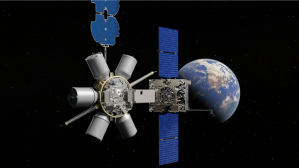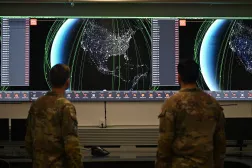Space Force moves to scale, enhance terrestrial data transport prototype

COLORADO SPRINGS, Colo. — The Space Force’s acquisition arm plans to award a follow-on production contract in the coming months for a ground-based system that provides a “data-transfer-as-a-service” capability for the service and other partners.
In 2021, Space Systems Command (SSC) awarded a $46.5 million pathfinder contract to Sev1Tech to prototype meshONE-T, a terrestrial network of data transport nodes that facilitates secure and rapid communications between sites located around the world.
Now, the service intends to issue a production contract to the company by the end of fiscal 2024 that will expand the scope and capabilities of the system, according to Col. Peter Mastro, senior materiel leader for the tactical command, control and communication delta within SSC’s battle management command, control and communications (BMC3) program executive office.
“It is a data-transport-as-a-service, where it provides a long-haul terrestrial fiber network to other programs that need it,” Mastro told a small group of reporters April 11 during the annual Space Symposium. “When a customer comes in and uses meshOne, it is a multi-path, resilient terrestrial comms to add that proliferated terrestrial path.”
The program is supporting the Pentagon-wide effort known as Combined Joint All-Domain Command and Control (CJADC2). The warfighting concept seeks to deploy technologies that help connect platforms and weapons from all the services and key foreign partners under a single network, enabling faster and more effective decision-making and force employment.
Programs today often set up and accredit their own closed, mission-specific networks through their prime contractor in order to move data around — creating technical and procedural barriers to efficiently sharing data with other services and mission areas, Mastro explained. Even when two different networks use the same data repository, they each need to get an authority to connect to access that information, he added.
The meshONE-T network looks to break down those siloes by creating an integrated, ground-based network that can fit into the Department of the Air Force’s larger CJADC2 effort known as the DAF Battle Network. Specifically, the system is ideal for moving large capacity, big bandwidth and high-performance data between two sites, according to Mastro.
“You can buy into what we have, and in doing so you join an integrated network,” he said. “When you join the meshONE network — and even if you just get one node at your location — you now are connected to every other node in the mesh network.”
The meshONE-T technology also offers users cybersecurity capabilities based on zero trust, Mastro noted. The framework assumes networks are compromised by adversaries, requiring users to be constantly monitored and authenticated as they move through a network.
Not only does that mean the architecture is protected, it also allows users to track data as it moves through the meshONE-T network and keep an eye on its performance in real time, he said.
“It’s that same type of visibility and insight that also gives cyber operators the ability to be on the system and to be monitoring who is in there to make sure that we understand what is going on,” he explained.
Since awarding the initial contract in 2021, SSC has deployed 17 meshONE-T nodes in and outside of the continental United States, according to Mastro.
The network has already supported a number of CJADC2-related programs — including demonstrations for the Advanced Battle Management System (ABMS) and the cloud-based command and control capability (CBC2) — as well as the Space Force’s Next-Generation Overhead Persistent Infrared (Next-Gen OPIR) program for missile warning and tracking.
In its budget request for fiscal 2025, the Space Force is looking for $42.1 million in research-and-development funding to support the follow-on contract for meshONE-T that will increase the number of nodes to expand the network. Mastro said while there isn’t a planned number of nodes they want to scale to, SSC has a list of programs touching “just about every part of the Space Force” that are interested in joining the network.
The service is also looking to enhance the overall capability of meshONE-T, such as becoming federated into other space-based networks, including systems in low-Earth orbit.
“We are going to be connected to [satellite communications] — both traditional military SATCOM, as well as commercial proliferated LEO [and] government proliferated LEO,” Mastro said.






